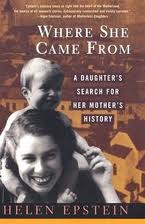 Shortly after her mother Frances died in 1989, writer Helen Epstein began visiting the university library near her Boston-area home, browsing through books on death, on Jews and on Central Europe.
Shortly after her mother Frances died in 1989, writer Helen Epstein began visiting the university library near her Boston-area home, browsing through books on death, on Jews and on Central Europe.
“I was mourning my mother,” she explains in her latest book Where She Came From: A Daughter’s Search for Her Mother’s History, “and if you had asked me what I was looking for in that enormous tomb of books, I would have said that I was looking for her.”
Epstein also began writing letters to archival institutions in the Czech Republic and elsewhere, seeking traces of her mother’s family. She had been told that her great-grandmother, Therese Frucht, had been an innkeeper’s daughter who, like the composer Gustav Mahler, had lived in the Moravian city of Iglau.
By visiting the towns where her ancestors once lived, Epstein discovered enough about them, and the life they led in the century before the Holocaust, to fill the pages of this well-written and moving book, published recently by Little, Brown & Co.
Assisted by Jiri Fiedler, a foremost expert on Czech Jewry who is himself a Gentile, Epstein was drawn to a series of hill towns around Iglau, including Brtnice, where she met a kerchiefed 85-year-old woman who remembered the Fruchts; the family name had previously been Furcht. “The casualness with which she used the name Furcht took the air out of my lungs,” Epstein records. “I went numb. I sat down on the bench, scattering the hens, and let my companions ask questions.”
Soon after, she and a companion reached the wooden doors of Brtnice’s old Jewish cemetery, which were locked. Epstein’s friend “felt none of my hesitation. He walked up to the closed padlock, gave it a sharp tug, and the entire bolt fell off the tall wooden door. He opened it, I followed. The grass was high but the graves were untouched. There in the first row, directly facing us, were two tall, marble tombstones which, in bold letters, read FURCHT and FURCHT. I stood rooted in place, a weight lifted from my head, my blood at rest.”
In researching her book, Epstein drew upon a 12-page family history written by her mother and an oral history that she had taken from her mother in 1974. She also consulted the Czech State Central Archive in Prague as well as local archives in Kolin, Iglau (Jihlava) and Brtnice.
Like another recent genealogical work, Theo Richmond’s Konin: A Quest, Epstein’s book is told as a personal quest into which the author projects her feelings, uncertainties and reactions as the research progresses. Where She Came From is ultimately a tale of Epstein’s own entry into the world. She draws out the story of her maternal ancestors, ultimately coming forward in time to tell of her mother’s experiences in Terezin and Auschwitz and the immediate post-war era, when she met her father Kurt Epstein, and produced Helen, the first of three children.
Since ordinary life is not normally the stuff of literature, the writer of a multigenerational family chronicle may be tempted to abandon the historian’s natural restraint and adorn and embellish at every turn. Montreal writer Elaine Kalman Naves, for example, employed a technique called “creative non-fiction” to add drama and fill in gaps in the narrative of her recent excellent family history Journey to Vaja.
Most of the time, Epstein shapes the natural drama of her family’s past without seeming to embellish. In a few spots, however, the narrative seems overly polished, and the reader is sometimes left wondering how certain details could possibly be stated as fact. But Epstein, best known for her groundbreaking 1978 work Children of the Holocaust, is generally careful.
The late American genealogist Rabbi Malcolm Stern once noted that nothing is more fascinating to the genealogist, nor potentially more boring to others, as the newly-discovered details of one’s family tree. It is to Epstein’s credit that, except for a few scholarly passages, Where She Came From keeps the reader eagerly turning pages. By relating her family’s history, Epstein provides an interesting summary of the sociopolitical history of Czech Jewry over the last two centuries. ♦
© 1999





